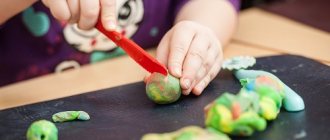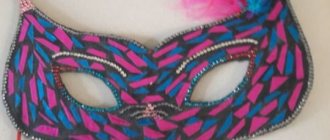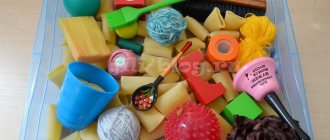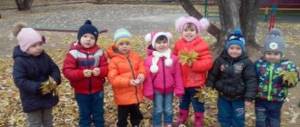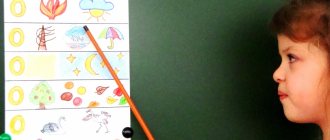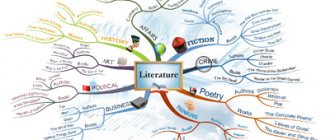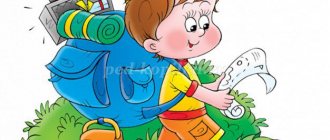Another Health Month event in our kindergarten is a competition of non-standard physical education equipment. It was enough to imagine one thing, but having discovered a lot of interesting ideas on the Internet, I wanted many! Therefore, without inventing anything, we repeated an already existing experience. Having tried our simulators on children, I agree that the colorful multifunctional aids delight children! They enrich motor experience, allow you to diversify movements in a new, more interesting form, develop a sense of shape and color, imagination and creativity. Thanks to them, the children's interest in physical education has increased, and all the children join us during exercise!
We present to you non-traditional physical education equipment, made from improvised (or simple) materials with your own hands and with the help of parents.
Theater "Friends of Moidodyr"
, which will help strengthen children's hygiene skills: Soap, Sponge, Towel, Handkerchief and Microbe. An entertainment script for children with the participation of parents has already been prepared. Unfortunately, I didn't save the link.
"Get into the bowl"
— a guide for developing hand motor skills and eye skills, consolidating knowledge of primary colors. Made from cardboard laminated with tape, plastic bottles and colored self-adhesive tape. Knitted balls are tactile (soft and crunchy). link
Tutorial “Blow a butterfly off a flower”
helps increase breathing volume, develops the ability to perform smooth, long exhalation. Material: discs, self-adhesive tape, electrical tape, colored paper. link
Manual “Colorful Snakes”
.
Goal: prevention of flat feet in children, development of fine motor skills, development of mathematical skills. Material: lids, rope. link Tactile bags
made of fabrics of different textures, filled with nuts, pumpkin seeds, pasta and cereals.
Soft floor checkers, sand throwing bags, massage button mats, "Golf of the Future", "Twister 0+" with left and right prints, Elephant ring thrower for rolling the ball, Snake, knitted Giraffe ring thrower with a basket for throwing balls, tactile mat for practicing forward bends.
This equipment is made of plastic bottles with caps based on drape fabric.
Designed for barefoot walking, correction and prevention of flat feet, hardening. It is used for physical exercises, during wake-up exercises, and joint sports events with parents.
This equipment is made from pieces of linoleum.
Used for outdoor activities and entertainment, to reinforce the concepts: “right leg”, “left leg”, “right hand”, “left hand”. Promotes the development of coordination of movement, memory, dexterity, strengthening the muscles of the legs and arms, attention.
This manual is made from a plastic bottle, colored paper, and cocktail straws.
Used for breathing exercises. Develops respiratory organs.
Made from sticks and colored ribbons and ribbons.
Designed for performing general developmental exercises, breathing exercises, organizing outdoor games, and competition games. Promotes the development of respiratory organs and trunk muscles.
Made from plastic bottles, fishing line, Kinder Surprise capsules, for decoration: colored adhesive paper.
Designed to hit the target. Develops eye, attention, reaction speed, manual dexterity.
Made of plastic cubes, paper with silhouettes of a person performing various exercises.
Intended for use in independent play activities, organized educational activities, and for working at home with parents. Helps strengthen body muscles, develop general developmental exercises, attention, coordination of movements, and speed of reaction.
Made from a ball, a mat glued to a wooden base, a spring, and a mouse toy.
Designed to hit the target for playing individually, in pairs, or as a team. Develops eye, attention, reaction speed, manual dexterity.
Made from five-liter plastic cans and elastic.
Designed to develop strength.
Made from plastic bottles, colored tape and sand (or other material for filling them).
Designed to develop strength.
Made from small plastic bottles, filled with colored rain, candy wrappers, etc.
Designed to perform general developmental exercises, basic types of movements, massage and self-massage, prevention of flat feet, development of fine motor skills, used as substitute objects for role-playing games.
Made from aluminum hoop and thick fabric.
Designed for climbing. Used in outdoor games, when performing basic types of movement, in role-playing games.
Made from painted wooden blocks and clothesline.
Designed to perform basic types of movement, to develop movement coordination, and for independent play activities.
Made of thick fabric and filled with beans, you can use other filler (small pebbles, beads, peas, etc.)
Designed to perform general developmental exercises, basic types of movements, massage and self-massage, and prevention of flat feet.
Slide 2
“The health of our children largely depends on the organization of physical education in kindergarten and family...” N. M. Amosov.
Slide 3
An important direction in developing the foundations of a healthy lifestyle in children is a properly organized subject-spatial environment, first of all, a motor subject-spatial environment. It should be developmental in nature, diverse, dynamic, and transformable. To do this, in our group we use non-standard equipment, made by ourselves, because new sports equipment is always an additional incentive to activate physical education and health-improving work.
Slide 4
Goal: to expand the subject-development environment by creating new non-standard equipment from waste material with your own hands, which helps the full development of preschool children Objectives: To motivate children for physical activity through the use of non-traditional equipment in independent activities To develop the expressiveness and beauty of movements To develop creativity and imagination , when using this equipment Summarize and disseminate experience in the creation and use of non-standard equipment for the propulsion environment
Slide 5
Requirements for non-standard equipment Non-standard equipment must be: Safe, Maximum effective, Convenient to use, Compact, Easy to manufacture, Aesthetic.
Slide 6
Group Corner
Slide 7
At the physical education and health center we have a new product - “Massage Gloves”! This non-standard equipment, made by hand, pleases me and my children. "Massage gloves"
Slide 8
“Massage gloves” help to have a positive effect on the growth and development of the child’s body, relieve fatigue, improve blood circulation, and calm the nervous system of preschool children. The kids really liked them! Children play and massage themselves and each other with pleasure and desire! Massage is carried out to increase the overall tone of the body, to strengthen the immune system and improve the emotional state of the child.
Slide 9
Slide 10
Slide 11
To make “Massage Gloves” you needed gloves, beads or buttons.
Slide 12
Our group also has other non-standard physical education equipment:
Slide 13
“FIREWORKS IN A BOTTLE” Material: Plastic bottle filled with confetti, foil, pieces of foam, etc., with holes made in it. Cocktail tube. Goal: To teach proper breathing (inhale through the nose, exhale through the mouth). Usage: The child blows into a tube inserted into the lid. Breathing exercises in play activities.
Slide 14
Su-jok massage ball with spring rings The development of fine motor skills is very important for the full development of the brain. Thanks to activities and games for the development of fine motor skills, the child develops coordination of movements, learns to control his body, and concentrate attention on objects. No one can give a 100% guarantee that only through constant stimulation of the fingers will a child speak early or grow up to be a child prodigy. But developing hand motor skills is one of the simple and effective developmental activities. This is especially important for children with delayed speech development.
Slide 15
Material: “Silent simulator” - on the wall made of self-adhesive film, silhouettes of children’s hands and feet are pasted in different variations: “Silent simulator” Development: development of coordination of movements, spatial perception, understanding of spatial relationships (right - left). Training the muscles of the shoulder girdle, back, arms and legs, relaxation.
Slide 16
Slide 17
“The Winder Game” is a useful competitive game for preschool children. They are used to effectively train fine motor skills of the fingers. During the game, dexterity, coordination and speed of movements are improved. Winder games are used both in competitions and in individual work and in children’s free play activities. I bring to your attention a hand-made winder game. “Whose butterfly is faster?” "The game is a reel"
Non-traditional non-standard physical education equipment in kindergarten
“Health has been given to us from above, learn, baby, to take care of it”
One of the priority tasks of creating a healthy lifestyle in preschool children is creating motivation, training and instilling healthy lifestyle skills in preschool children.
An important direction in the formation of the foundations of a healthy lifestyle in children is a properly organized subject-spatial environment, first of all, a motor subject-development environment. It should be developmental in nature, diverse, dynamic, transformable, and multifunctional.
To do this, in our kindergarten we use non-standard physical education equipment made by ourselves, because new sports equipment is always an additional incentive to activate physical education and health work.
The task of promoting health is one of the priorities in the work of our kindergarten. The body's resistance to unfavorable environmental factors and the reduction in morbidity levels depend not only on the individual characteristics of the child's body, but also on the timely and correct implementation of special health measures.
When designing a subject-spatial environment for a group, a street area, sports and music halls, and a swimming pool, which promotes the formation of a healthy lifestyle for preschool children, we proceed from the need to take into account the following factors:
1) individual socio-psychological characteristics of the child;
2) features of his emotional and personal development;
3) individual interests, inclinations, preferences and needs of children.
Every year, the work of our preschool educational institution begins with the diagnosis of the physical development and motor activity of children, as a result of which physical education and health work is carried out aimed at improving the health of children (hardening activities, physical education classes, sports leisure activities, work with parents to promote a healthy lifestyle).
The effectiveness of the classes is influenced by high-quality and deeply thought-out preliminary work on preparing all the necessary aids and equipment that will help conduct the complex in a lively, emotional, and interesting way. Questionnaires of parents and conversations with them are mandatory. Our task is to saturate the group space, the street area of the group, music and gym halls, and the pool premises with inexpensive, non-standard, multifunctional equipment and inventory that meets hygienic, anatomical-physiological, mental, aesthetic, ergonomic and other requirements, which meets all sanitary and hygienic requirements and standards.
As practice has shown, the developmental environment alone already makes it possible to increase motor activity, to push the preschooler to movement performed of his own free will, desire, without coercion.
I have developed various types of exercises using non-standard physical education equipment made by me, colleagues and parents, which are successfully used in practice. Our group has created a physical education corner or “Health Corner”, where aids for the development of physical activity are available in a place accessible to children. This includes factory-made sports equipment and non-standard ones (tunnels, hemp, dumbbells, multi-colored flat circles, colored tracks, rattles, fabric balls, etc.).
Non-standard equipment is always an additional incentive to intensify physical education and health work. The use of this equipment and manuals increases the number of exercises for different muscle groups, and also allows you to use a differentiated method of working with children with various pathologies.
In our preschool institution there is a separate gym and exercise room, a swimming pool, a treadmill, a music room, each age group has its own area. Colorful multifunctional equipment installed in the gym, exercise therapy room, music room, swimming pool, and areas not only causes great delight in children, but also allows them to expand their opportunities for performing a variety of movements, exercises and games.
Children with great pleasure climb, run, jump, do all kinds of exercises, and play outdoor games. By using non-standard equipment, introducing elements of unusualness and new interests, we satisfy the child’s urgent need for movement. It serves as an important condition for the formation of all systems and functions of the body, one of the ways to understand the world, navigate in it, as well as a means of all-round development of a preschooler.
We believe that movement is the basis of health, so we set ourselves the following goals:
- create a development environment by introducing non-standard equipment;
help children gain experience and knowledge to strengthen their physical and mental health;
stimulate the inclusion of motor activity in the process, encourage him to self-knowledge, create conditions for the internal activity of the individual and his further successful socialization;
direct the joint work of the entire teaching staff and parents towards the development and hardening of the body of each child;
to develop the skills of self-regulation of a preschooler’s behavior, aimed at consciously preserving and strengthening their health, which will allow children to be physically, mentally and socially more prosperous during the transition from the artificially structured environment of a preschool educational institution to situations in the real world, everyday life.
EXPERIENCE IN WORKING WITH NON-STANDARD EQUIPMENT
In preschool educational institution No. 459
LIST OF NON-STANDARD EQUIPMENT AND EXERCISES WITH THEM:
Description of paths, tracks: waste material - bars sawn in half and mounted on a long board, mats woven from thick fishing line with wooden balls of various sizes attached to it (from small to large and from large to small) for tracks and tracks, parts of plastic covering with pile; Pieces of carpets of different pile textures, parts of a plastic construction set, tubes of multi-colored felt-tip pens, and markers are glued onto durable, rough plastic.
Bim - Bom, Bim - Bom, we are going to kindergarten. We walk along the path, strengthening our legs. Our legs, our legs, deftly walk along the path...
Tunnels
Description: fabric is sewn onto the hoop, the other end is free
pads
Description: made from various pieces of fabric, filled with dry cereal, small balls, small toys.
Sticks of different sizes
Description: well-polished sticks of different lengths and diameters and decorated with bright packaging materials.
Paths
Description: cut from carpets, with different textures and levels of pile hardness, wide and narrow, short and long.
Don't be afraid of the dark, crawl through the tunnel and find Drakosha!
Multi-colored balls
Description: 2 fishing lines are stretched from one wall to the opposite wall along the length of the hall, with 10-12 multi-colored balls threaded through them, which can be moved using a long stick held in a vertical position.
On walks, we reach for bells suspended on sticks, which the teacher holds, adjusting the height according to the height of each child.
To play on walks, I also use a large parrot I made with my own hands (with the help of my parents), which is hung from a high stand. Children take turns “feeding the parrot” by throwing small plastic balls called “grains” into it.
Magic jars, Magic bag
Description: waste packaging material. The lids are glued to the tin ones so that they do not open and are painted with paints in the same style or differently; cardboard ones can be used both for organizing the game “Shop”, “Home”, and for sports exercises: “Build a tower with legs”, “Step over, not hitting the top of the tower”, etc.
The bag is sewn from a small piece of fabric, which is tied at the top with a rope or an elastic band.
Skis made from plastic bottles
Description: the bottles are cut to fit the child's foot, the edges are covered with colored electrical tape or colored paper, which is reinforced with tape or tied with a large crochet hook and thick threads along pre-made holes.
Dumbbells
Description: white plastic bottles, decorated with a narrow colored ribbon, filled with 150-200g of sand
Multi-colored plane circles
Description: linoleum
Arcs
Metal and plastic arcs of different heights, mounted on stable stands, are decorated with packaging material secured with tape.
Rattles and balls
Factory-made and made from packaging material, ice cream and kinder surprises, filled with small balls, sand, cut-up straws for drinks.
Both standard and non-standard equipment are used constantly and in all types of children’s activities and in any classes.
The group site equipment was created with our own hands and with the help of the students’ parents.
EXERCISES
“Wanderers” We place the legs so that the “pigtail” is under the arch of the foot and walk sideways along the entire length.
“Legs - helpers” It is necessary to grab the toes of a resident of the house and lower him through the roof into the house. Or load the car with various loads without touching the loads with your hands.
“Big Construction” Playing with sand can be varied. And not only on the street, but also in a group. In our group we have a large container with sand in which children love to play not only with their hands, but also with their feet. During the game, you need to do everything only with your legs and toes.
“Put into containers” You need to grab the toy with your toes and put it in the container compartment.
In the same way, we divide small toys from Kinder Surprise, which are poured into a common container into different cups, so that everyone gets equally (you can compete to see who can pick up a lot of toys faster).
“A surprise for yourself” Lying on his back, the child (objects and toys are laid out in front of his feet) collects small toys and surprise objects into a box with his feet and closes it with a lid, then tells what he collected. Then we check everything together.
“Magic bag” Blindfolded, the child takes an object out of the bag, feels it, describes it, tries to name the object and determine its purpose.
It is interesting and unusual to use the toys that they bring from home when working with children. “Fishing rod with fish” We hold the fishing rod with our foot and catch the fish. Everyone plays and we hold competitions between our legs. Which leg (left or right) caught more fish wins!
“Lilliputians in Gulliver’s Country” The bell is hung on a stick and the teacher adjusts the rise of the stick depending on the height of each child. You need to call it by reaching out.
“Feed the parrot” (you can take any other toy - a mitten) Everyone needs to throw a “grain” - a ball - into the mitten. But it’s not just a timid parrot that sits high! Reach out and feed!
“Knight's tournament” Using boxing gloves, we unwrap small objects. You can hide one hand in a glove and leave the other free.
“Cinderella” We mix various cereals for children. The older the children, the smaller the cereals! You can take peas and beans. They sort while kneeling or lying down into different containers.
Relay race “Reach for the picture” Children need to reach out to part of the picture and disconnect it. Then, when all the parts have been removed, you need to assemble the picture. The team that collects the picture faster will win.
Relay race “Sew a dress for a friend” For work you need to collect flowers and laces. Each of the children selects 1 flower and 1 lace from the total mass with their feet, then, following the “magic paths,” “sews” the flower to the dress. The team that “sews” the dress the fastest will win.
“Getting ready for a hike” Using the legs, we put into the backpack those items and things that are needed on the hike, and fasten it. In the same way, “Getting ready for school,” “To grandma’s in the village,” etc.
“Visiting the Rabbit” We put a small toy in the small Bull-backpack - a gift for the Rabbit. You need to crawl under the arches and walk through the tunnel so that the gift is not damaged. Arches can be of different heights, descending or ascending.
“Help the guests get to the Mole” The tunnel is the Mole’s hole. Guests are toys. You need to crawl through the tunnel with toys - guests and deliver them to the Mole.
“Pencils in glasses” Children have a large mass of colored pencils for drawing in front of them. Use your toes to arrange the pencils among the glasses so that each glass contains pencils of all colors.
“Lids” It is necessary to screw the caps onto the bottles with your toes, which are held by another child also with their feet, first on one, for example, with the right foot, then with the left foot on the other bottle. Then the children change places.
“Legs are artists” You need to hold the brush with your feet, you can draw something with one. Then we all look together at who did what.
“Water Carriers” There are two containers in front of the child. One with water, the other empty and a spoon. It is necessary to use a spoon, which we hold with our toes, to pour water from a full container into an empty one.
“Builders” We use our feet to build a building from wooden building material. Then we all decide together whose building is better and stronger.
“Legs and arms” The child holds the sticks between his palms and between his feet and tries to twist them at the same speed.
Having non-standard equipment, a teacher can simulate a lesson, diversify holidays and entertainment. After all, active actions with objects during exercises contribute to the knowledge of color, weight, shape, quality of material and other properties of the object, allowing you to build the learning and development process in an interesting way and with maximum benefit for the child.
Instilling healthy lifestyle skills and creating motivation for doing gymnastics and sports are among the priorities for strengthening a child’s health. An important role is played in this by a properly organized subject-spatial environment, which should be developing, interesting, and stimulating for physical activity. To do this, they often make equipment for kindergartens with their own hands. This equipment facilitates new and exciting games in the classroom. It allows children to “take a break” from boring exercises, and teachers - to implement new tasks with minimal financial expenditure.
For new equipment you will not need much: various waste materials (ribbons, bags, Kinder egg cases, etc.) and, of course, your patience.
The equipment proposed in the article can be used both in the everyday life of children and in physical education classes.
DIY kindergarten equipment: breathing exercises
Game “Feed the Beast”: you need to blow the Kinder Surprise case into the hole. Children not only train in accuracy, but also develop their eye.
Game “Let's Drink Tea”: you need to cool the tea by blowing on the rising “steam”.
Game "Blow the Butterfly" The exercise can be complicated by the task of blowing a butterfly onto another flower so that children learn to control the force of breathing.
Game “Wind Blow”: you need to blow on the leaves/snowflakes so that they sway.
Equipment changes depending on the season. In winter, snowflakes are hung from the ceiling, in spring - flowers, in summer - butterflies, in autumn - leaves.
Non-standard physical education equipment for working with preschoolers “Quiet simulator”
Alina Ramazanova
Non-standard physical education equipment for working with preschoolers “Quiet simulator”
One of the most important tasks for the full physical development of a child is to satisfy the natural need of children to move. Your inner world (pleasure, surprise, concentration, joy, etc.)
the child can express with movement.
Insufficient motor activity of children leads to a deficit of cognitive activity, knowledge, skills, muscle passivity and a decrease in the body's performance .
In a group with a lot of children, furniture, toys, it is impossible to run, throw a ball or jump rope. Thus, our task is to teach children independent motor activity in a small area (group)
.
Preschool children , often very active, cannot correlate their desires with the capabilities of the group. Traditional outdoor games are difficult to carry out in a room where there is a lot of furniture, toys, and, in addition, such games often require the participation of several players.
If you show children games with “ silent simulator ”
, then as a result, the chaotic spontaneous activity of children will decrease. The duration and intensity of movements will increase. The movements themselves will become more varied. The number of traumatic situations will decrease.
What does the “Silent Trainer ”
Tasks:
didactic: teach children spatial perception (left and right, top, bottom)
developing: promote the development of coordination, spatial imagination and perception. Training the muscles of the shoulder girdle, back, arms and legs
educational: create an emotional positive attitude towards playing with the simulator . Relaxation.
Organizational rules: up to 6 children can play the simulator The adult presenter attaches the exercise machine to the wall or places it on the floor (depending on the version of the game)
.
Silhouettes of palms and feet of different colors are attached
to the simulator Disciplinary: children perform exercises on the simulator in turn order . They do not push and do not interfere with the exercises.
Game actions: the leader controls the correct execution of the exercises. The child performs the exercise according to the instructions.
Material: " Quiet Trainer "
- these are silhouettes of children's hands and feet pasted on the wall in various variations from the floor to 1.5 m in height:
— silhouettes of children’s hands (5-7 pieces each)
duration
(1-1.5 meters)
;
— silhouettes of legs from the floor to a height of 70 cm;
— silhouettes of legs and palms are pasted in different positions;
-multi-colored stripes (5-10 pieces)
length 1-1.50m. for bouncing.
Usage: children lie on the mat on their backs and try to “walk”
along the path.
They start from the floor, gradually raising their legs higher, moving into the “birch”
.
Children begin to place their palms on the lower silhouettes and reach the upper palms. Children walk along the silhouettes with their palms , while their hands have to be turned in different directions, just like with their feet.
GAMES WITH SILENT TRAINER
GAME “GET THE MOUSE”
Goal: development of coordination, spatial imagination and perception, understanding of spatial relationships (right-left)
;
training the muscles of the shoulder girdle and arms.
Organization: on the wall, above the silhouettes of palms, a picture of mice is pasted.
How to play: On command, a couple of children must rise on their palms from the floor to the mouse . You can only lift one hand off the wall. Hands are placed on the silhouettes, observing right and left. The one who gets the mouse first wins.
GAME “WALK ON THE WALL”
Goal: development of coordination, training of back and leg muscles , relaxation.
Organization: a soft rug is laid out near the wall.
How to play: Children take turns lying on the floor and trying to “pass”
along the path on the wall.
They start from the floor, gradually raising their legs higher, moving to the “birch”
.
GAME “JUMP TO THE STRIPE”
Goal: development of coordination, spatial relationships (right-left, exercise in standing high jumps, foot training .
Organization: children line up in a column one at a time. Multi-colored stripes are pasted on the wall at a height from the outstretched arm of the shortest child to the jump height of the tallest.
How to play: Children take turns jumping up against the wall, trying to reach the multi-colored stripes as high as possible.
GAME "CONFUSION"
Goal: development of coordination, spatial imagination and perception, understanding of spatial relationships (right-left, training the muscles of the shoulder girdle and arms.
Organization: silhouettes of palms are pasted on the wall in random order. Children can play alone or in pairs.
Progress of the game: Children walk with their palms along the silhouettes from bottom to top; hands can only be placed on paired silhouettes (right-left, while the hands have to be turned in different directions.
1st option – the child plays alone and just “walks”
hands on the wall;
2nd option – children play in pairs “Who will get to the conditional mark faster?”
. In this case, hands can cross, children change places, but do not take their hands off the wall;
3rd option – one child is the leader, he gives commands to the other child where to go (for example, right is red, left is green, etc.)
Options for playing with a floor simulator :
Option 1: Silhouettes of palms (feet)
directed in different directions
(inward or outward)
Option 2: Silhouettes of palms and feet are attached in different orders. Children walk along the path in accordance with the silhouette.
Option 3: Silhouettes of feet are attached to the left side, silhouettes of palms to the right. Children take turns touching their palms and feet.
Option 4: Children walk the path according to the instructions of the leader. (e.g. left hand - left leg, left hand, right leg)
Exercise machines using the circuit training method in a preschool institution
Our preschool has a gym that is used both for physical education classes and as a “dry pool” if there are no classes in the water for some reason.
As observations show, training on simulators arouses interest among both older and younger preschoolers. It’s just that exercise machines are more accessible to older children; they perform the exercises more consciously, correctly, and “feel” the muscle load better.
Classes contribute to the development and strengthening of various muscle groups and the entire body as a whole, develop many physical qualities, and diversify the educational and pedagogical process.
The simulators are quite simple in design and easy to use. Children are introduced to their work individually or in a small subgroup.
Together with complex equipment, it is important to use the simplest type of exercise equipment (children’s dumbbells (0.5 kg), shoulder and wrist expanders, “Health” discs, gymnastic rollers, etc.).
Among complex device simulators we use:
The “Lower Row” (“boat row”) exercise machine is for the muscles of the arms, chest and torso. Basic exercises:
- Perform horizontal rows (hands to chest), sitting, slowly.
- Thrust to the chest - abduction from the chest - bending back and back.
- Pull to the chest - hands grab the handle from below.
- Standing - pull towards the chest, bend at the lower back.
The parallel bars exercise machine is for training the abdominal and arm muscles, for developing the strength and endurance of the abdominal muscles.
Basic exercises:
- Place your emphasis on your forearms and hold the handles of the machine with your hands. Feet on stands. Lower your legs straight down and hang on your hands.
- I.p. - Same. Raising straight legs forward.
- Raising the legs with the knees bent.
Exercise machine "Leg press" ("machine") - for training the leg muscles.
1. Pushing off the platform with your feet until your legs are fully straightened,
your back is pressed tightly against the back of the seat.
The exercise bike is designed to strengthen leg muscles, develop endurance, and train the respiratory and cardiovascular systems.
Exercise machine “Stepper” (“steps”) - for working the arms, legs, and developing coordination.
Basic exercises:
- Walking in place (increased pressure with your feet on the platform) with your hands on your belt or holding the handles.
- Walking in place, hands move the arms back and forth, coordinating the movements with the legs.
Massage track – for developing coordination and foot massage.
“Walking” simulator - for the muscles of the legs, back, oblique abdominal muscles, coordination training, imitation of movements like when skiing.
Contents of classes with complex device simulators.
At the beginning of the lesson (introductory part), a short warm-up is carried out, no more than 3-5 minutes. It includes walking at different paces and with different leg positions, running, breathing exercises, and walking in place.
In the main part, children take seats on the exercise equipment and complete tasks. Each task is repeated 10-15 times depending on the child’s capabilities (motor, age, functional). During execution, I mark mistakes, monitor the load (pace, number of repetitions, duration of exercises), and encourage the children. The duration of work on one simulator is on average no more than 1 minute. After this, children stand near the exercise equipment and do breathing exercises, relaxing movements, coordination exercises, self-massage, and say tongue twisters. Perform a choice of 1-2 exercises.
Then the children move on to the next simulator, and this is repeated until they have completed the entire circle. During the lesson they complete 1-2 laps.
The final part ends with breathing, relaxation, and stretching exercises.
The total duration of the lesson is 25-35 minutes.
During the classes, it became clear that children with a high level of physical fitness very quickly master the entire learning process; 1-2 demonstrations with small explanations and clarifications are enough. Sedentary and weakened children require a clearer and more detailed explanation with multiple demonstrations. We need to encourage them in every possible way to make them believe
in your own strength. A prerequisite is medical and pedagogical control in the classroom, the creation of a favorable environment: goodwill and respect for everyone.
the child, providing assistance and support to make him feel independent, confident and protected in any situation.
Currently, preschool educational institutions are faced with the urgent question of ways to improve work to improve health and develop movements. In recent years, the health status of children has been progressively deteriorating. Currently, many children already at preschool age have problems with the musculoskeletal system. Most of these children are sedentary or, conversely, overactive. They are distinguished by an unstable psyche and undeveloped self-regulation processes. They often get sick, have a low level of physical development and, as a result, weak musculo-ligamentous apparatus.
New approaches to the content of physical education classes help improve the health level of modern preschoolers. Therefore, our teachers use new approaches to organizing physical exercise classes in their work. Modern physical education in a preschool institution should prevent diseases, that is, be preventative. In classes with weakened children, preventive physical education programs should be used. We see this solution in the organization of fitball-gymnastics in preschool educational institutions. Fitballs (from the English Fitball; fit - health improvement, ball - ball) are a large ball with a diameter of 45cm - 70cm.
The use of fitballs in our preschool educational institution allows us to solve many health problems.
The training program on such balls is unique in its effect on the body of those involved. The main goal of the exercises is to strengthen the musculoskeletal system, create a muscular corset, improve mobility in the joints, and create optimal conditions for the development of the child’s intellectual, emotional and volitional sphere. When performing physical exercises on balls, the motor, vestibular, visual and tactile analyzers are simultaneously turned on, which exponentially enhances the positive effect of the exercise.
Classes on fitballs in our preschool educational institution begin at 4-5 years of age. At the first lesson, children have the opportunity to get acquainted with new equipment. To do this, children need to be given the opportunity to play with the ball on their own. In this case, it is better to choose balls of large diameter so that the child cannot climb on it and fall. At the next stage, we need to teach children to sit down and maintain balance on the ball. It is advisable to do this separately with each child, insuring him from the side or from behind. When landing on the ball, the angle between your shin and thigh should be 90 degrees.
There are average optimal ball sizes for preschool children: 4-5 years old - 45cm; 5-6 years – 50cm; 6-7 years – 55cm.
The ball is multifunctional in its properties and can be used in fitball aerobics programs as an object, exercise machine or support.
The effectiveness of fitball gymnastics depends on the correct selection of teaching methods and techniques. In early preschool age, when teaching physical exercises, demonstration, imitations, visual, and sound cues are used to a greater extent.
Demonstration is used when children are introduced to new movements that are demonstrated several times. The technique of imitating the actions of animals or phenomena of nature and social life is very helpful in teaching children physical exercise. Imitating, for example, the actions of a bunny, children get into character and jump on fitballs with great pleasure. The positive emotions that arise in this case encourage you to repeat the same movement many times, help to consolidate a motor skill, improve its quality, and develop endurance. Visual references help children clarify directions of movement and diversify their activities. Sound cues are used to master the rhythm and regulate the tempo of movements on the fitball, and also as a signal for the beginning and end of an action, for emotional uplift. Musical accompaniment on a piano or audio recording, beating a tambourine, clapping hands, etc. are used as sound references.
Individual assistance in teaching physical exercises is used to clarify the fit on the fitball, to create the correct muscle sensations, to create confidence and success.
At an older age, with the expansion of children's motor experience, the role of verbal techniques without accompanying demonstration increases; more complex visual aids are used to clarify the construction in the form of a diagram or photograph.
In order to consolidate motor skills, exercises on a fitball should be carried out in game and competitive forms. As a result, a special physiological and emotional background arises, which enhances the impact of exercise on the body and promotes the manifestation of maximum functionality and mental strength. At the same time, higher demands are placed on physical, moral and volitional qualities (decisiveness, honesty, nobility, etc.). Those exercising with fitballs should be at a distance of 1-1.5 m from each other and from protruding objects in the hall. When performing exercises in combination with oscillatory swings on a fitball, it is necessary to control constant contact with the surface of the fitball. The pace and duration of exercises are individual for each child.
Sets of exercises on balls, depending on the tasks set and the choice of means, can have different directions:
- to strengthen the muscles of the arms and shoulder girdle, abdominals,
- to strengthen the muscles of the back and pelvis, muscles of the legs and arch of the foot,
- to increase flexibility and mobility of joints,
- for the development of balance and vestibular function,
- to develop dexterity and coordination of movements,
- for the development of plasticity and musicality,
- for relaxation and relaxation, etc.
Corrective and recreational gymnastics on balls has its own structure:
1 . The preparatory part is warming up the body and creating a positive emotional mood.
It is carried out without balls and includes various types of walking, running and musical rhythmic movements.
Types of sports equipment
To equip a place for physical education in kindergarten, the following are most often used:
- Swedish walls;
- balls;
- gymnastic mats;
- hoops;
- jump ropes;
- basketball hoops.
It is worth remembering about the musical accompaniment. For this purpose, an acoustic system or tape recorder is usually installed. Also, there is usually equipment that is made by the teachers and parents themselves. Examples include the following items:
- Health tracks created on a fabric base on which, for example, buttons are sewn. Such devices help massage children’s feet and are a means of preventing flat feet.
- Breathing exercise equipment. An example is paper figures that students must blow off the table.
- Games similar to “twister” with images of feet and hands. They contribute to the development of children's coordination of movement and the development of spatial perception.
- Expanders.
- Various masks. They are necessary for outdoor games.
When setting up a sports corner, it is worth remembering that the list of items is limited only by the imagination of the teachers. Therefore, if possible, it is worth spending time creating new inventory. By creating a sports corner in a kindergarten with your own hands, you can be sure of its reliability and safety.
